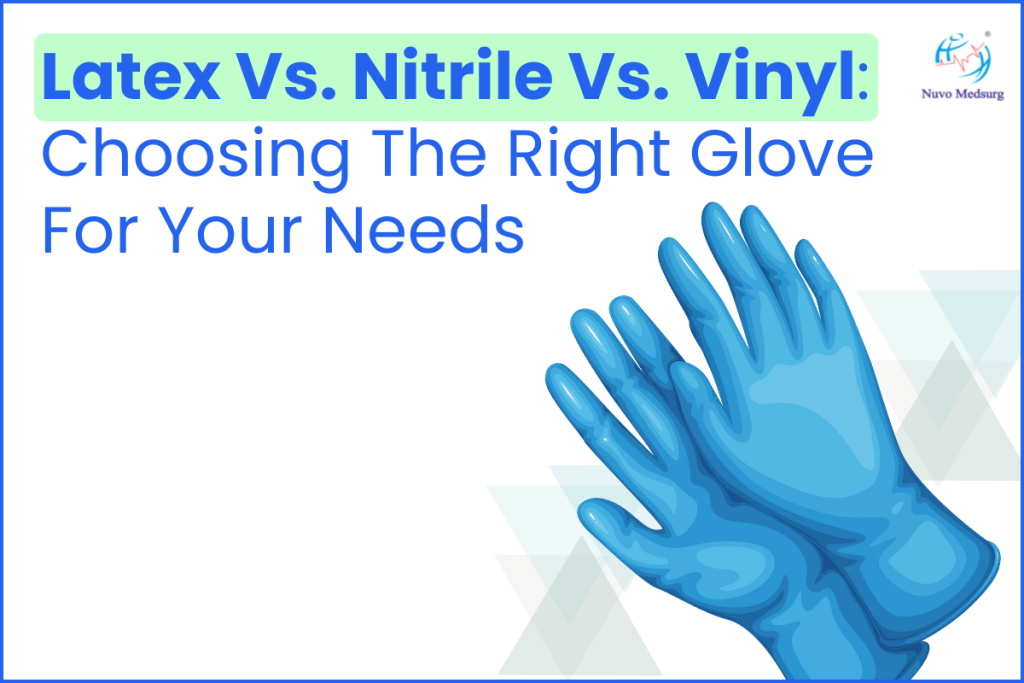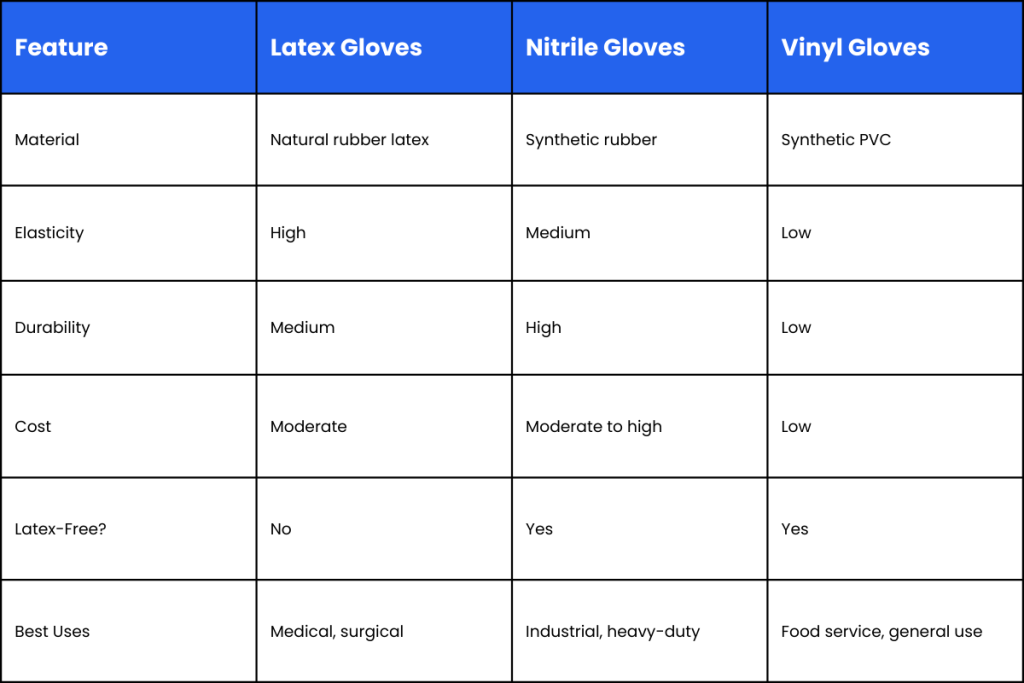Subtotal ₹0.00

You should be aware of disposable gloves due to their importance in almost all settings, whether in the healthcare profession or food service; manufacturers use them. Latex gloves, nitrile gloves, and vinyl gloves dominate the market, and they all have their own sets of standards for various functions. Understanding these differences is the first step to your selection of gloves, not only medical gloves but also nitrile hand gloves; most frequently, it will be the choice between surgical and general-use gloves, which will be made for ideal protection and practical use.
Table of Contents
Disposable gloves constitute the cornerstone of hygiene and safety and, in turn, protection from cross-contamination. Given their innumerable applications in today’s fast-paced industries, the demand for some means of reliable hand protection cannot be overemphasized. The factors to consider when selecting gloves include fit, durability, sensitivity, and allergy issues. Understanding the ins and outs of various materials- latex, nitrile, and vinyl—enables improved judgment with, among others, respect to your needs, depending on whether that be guides for high-risk medical procedures, industrial tasks, or food preparation. Let us check their characteristics, benefits, and typical applications below.
What Are Latex Gloves?
Latex gloves are made of rubber latex; the sap from the rubber tree is coagulated and manufactured in various styles to provide good elasticity and flexibility. Because of their natural composition, these gloves tend to be biodegradable, which is a great plus for an environment-protecting world. Latex gloves fit snugly with excellent dexterity, making them the choice type of glove for tasks requiring care and tactile sensitivity.
Latex gloves present excellent protection as a barrier against pathogens, bacteria, some chemicals, and other similar agents involved in their career. Hence, they are the inventor’s preferred choice for an individual healthcare-object task, as it requires precision and safety. Latex gloves are either lightly powdered or powder-free.
Advantages
- Comfort-and-Fit: Latex gloves are supposed to be the best in comfort and fit. The natural rubber material forms smoothly around the hand, guaranteeing that users can conduct intricate tasks without discomfort or restriction.
- Biodegradability: Latex gloves are made of natural materials, so they decompose more easily and quickly than their synthetic counterparts, helping reduce environmental impact.
- Barrier Protection: Latex gloves afford plenty of protection against biological hazards; hence, they form a very sensible choice for medical personnel and researchers.
- Tactile Sensitivity: Thin but strong, they offer extraordinary tactile sensitivity, allowing precise, reasonable handling of instruments and materials.
Common Uses
Due to their diverse and high-performing qualities, latex gloves are commonly used in many venues. Due to their superior tactile sensitivity, these are often used during delicate procedures when precision is crucial. The conditioned dentist relies on latex gloves to keep the patient – and himself – safe and maintained with reasonable control of all treatments.
Other than in medicine and dentistry, latex gloves are used in the laboratory for protection when touching sensitive equipment or chemicals. They are also very popular in the cleaning industry since their barrier properties protect against typical cleaning agents. That said, using rubber gloves may not be suited for everyone because of possible latex allergies; for this reason, nitrile or vinyl gloves would be great alternatives in this case.
What are Nitrile Gloves?
Nitrile gloves, made from synthetic rubber, are equally famous for their use with people allergic to latex. Its splendid resistance to puncture tears and a full range of chemicals place it in the tough and versatile gloves category. Nitrile gloves come in several thickness levels, from thin to ultra-thin, to allow dexterity and thickness for heavy-duty use.
The strikingly distinguishing feature of nitrile gloves is resistance to oils, greases, and solvents, thereby making the glove category most valuable in industrial and automotive surroundings. They differ from latex gloves in that they preserve their integrity considerably better than latex gloves when exposed to destructively harsh substances.
Advantages
- Durability: Being strong and rigid, nitrile gloves suit rigorous, high-risk tasks.
- Chemical Resistance: Nitrile gloves are preferred because they are resistant to oils, solvents, and chemicals used extensively in laboratory and industrial applications.
- This would be the allergy-friendly one that has no latex in it.
- Variety is the spice of life; nitrile gloves vary in thickness and colour, ranging from medical to heavy-duty work in the industry.
Uses
Nitrile gloves are a mainstay in some medical, industrial, and laboratory settings. Their excellent resistance to piercings makes them ideal for working with sharp instruments and tools. Also, their defence means they may be required to handle certain hazardous materials. Healthcare workers would use nitrile gloves when working with procedures that might have them dealing with body fluids or pathogens.
What Are Vinyl Gloves?
Vinyl gloves are synthetic rubber latex material made from polyvinyl chloride (PVC). They provide a more comfortable and softer touch than latex gloves; however, they are not as strong as either latex or nitrile gloves. Vinyl gloves are a relatively cost-effective and easy-to-confer solution for low-risk procedures. Being latex-free, vinyl gloves can also suit individuals with latex allergies or sensitivities.
They’re far less elastic than latex and nitrile gloves, which play for most of their adjustability, making them looser for wear. Nevertheless, despite this elasticity problem, these gloves serve their purpose very well, especially for tasks requiring ordinary, not precise or particular handling. There are powdered and non-powdered vinyl gloves to suit depending on the preference of individuals.
Advantages
- Cost-Effectiveness: Vinyl gloves are more cost-effective than others, making them the best option for high-volume use in low-risk workplaces.
- Latex-Free: Being synthetic, these gloves are safe for latex-sensitive persons.
- Versatility: They might lack the strength of other, more specialized formulations. Still, their handling in the context of general usage has earned it a position of respect and their application in several tasks.
Common Uses
The inexpensive, biodegradable and easy-to-use styles are commonly used in food service. They are suitable for light cleaning jobs and can be a barrier against dirt and mild cleaning agents. Vinyl gloves may be used in healthcare for non-invasive examinations and low-risk procedures.
Although not as durable and protective as latex and nitrile gloves, they are still a viable choice for applications where the risk of exposure to hazardous substances or sharp objects is minimal. Their principal attraction is that they are cheap, readily available and appropriate for everyday use in homes, schools, and businesses.
A Guide to Choosing the Right Gloves for Your Needs
Factors to consider when choosing disposable gloves include:
– Intended Use
Where strength and high sensitivity are required, latex or nitrile gloves can be used in healthcare and surgical settings.
When food handling occurs or light tasks, vinyl gloves are inexpensive.
– Allergy
Use nitrile or vinyl gloves if you or your staff suffer from latex allergy.
– Chemical Resistance
Select nitrile hand gloves if the use involves chemicals or potential puncture risks.
– Price
In many uses with minimal risk, a budget glove option is vinyl.
For instances where higher protection is needed, nitrile gloves will vastly pay for themselves.
– Comfort and fit
Latex has high comfort and flexibility, but individuals with sensitivities to latex mustn’t use it.
Role of Gloves in Food Safety
Disposable gloves are essential to ensure food safety and hygiene since they protect the food from contamination. These gloves are most commonly manufactured from vinyl since they are inexpensive and easy to use. However, it is essential to choose the right type of glove in favour of protection from pathogens along with adherence to hygiene standards.
Changing gloves often is a requirement always in a lot of food safety guidelines as a manner of discarding the opportunities for cross-contamination. For instance, it would be improper to handle raw meat and go on to handle fresh produce without a change of gloves. Hence, nitrile gloves have grown in popularity with everyday tasks in food due to their superior strength. They offer much more resistance to being punctured and can withstand oils and fats much better than vinyl gloves.
Colour-coded glove systems are another improvement in food safety protocols through correctly identifying glove colours for different tasks, such as raw meat versus ready-to-eat items. This straightforward step will diminish the likelihood of cross-contact and properly empower food safety standards.
Considerations for Choosing Gloves
When choosing your gloves, consider your work environment. Is it the case that you are in healthcare or another high-risk industry where you could be exposed, for example, to numerous pathogens? Or is yours a low-risk environment, such as food preparation? Also, the glove’s thickness is another aspect that influences its protective quality and dexterity according to a given task.
Powder is also another consideration. Powdered gloves make it easier to slip gloves on and off; however, in some instances, the powder might provoke allergic reactions. Latex gloves have been adopted for sensitive environments, like medical and laboratory settings.
Environmental Impact of Disposable Gloves
The increasing demand for disposable gloves has drawn extra attention to the issue of environmental impact. Thus far, biodegradable latex gloves have a smaller environmental footprint than the other two. Improper disposal, however, particularly that of nitrile and vinyl gloves, is said to lead to long-standing waste in landfills. Contamination matters limit the options for recycling, and some attempts are being made in some countries to recycle nitrile gloves in the industrial sector.
Plastic consumers and organizations alike can lower the adverse impacts on the environment by choosing biodegradable choices as often as possible, properly disposing of gloves, and investigating reusable glove alternatives for low-risk applications. Educating oneself and following local waste management guidelines would also help reduce environmental damage.
Innovations in Glove Technology
The glove industry is moving forward. Innovating in gloves focuses on developing high performance, comfort, and sustainability. Fabricating gloves with a better tactile feel and grip also gain traction. Innovations in material technology are directed toward synthesising the elasticity of latex strength means of nitrile with the relative affordability of vinyl.
Plant-based or sustainably manufactured gloves are picking up steam as eco-conscious options. Antimicrobial gloves are being produced for use in healthcare to suppress the risk of infection. These technologies can provide consumers better options to meet their needs as they become more widely accessible.
Latex-Free Alternatives: A Growing Demand
The demand for latex-free gloves is growing due to the increasing number of individuals with latex allergies. For this reason, many industries now turn to nitrile and vinyl gloves to stand in for them. Nitrile gloves have been widely acclaimed due to their excellent resistance to chemicals, punctures, and tears, making them suitable for various high-demand functions.
Vinyl gloves are the lowest-cost latex-free gloves, mainly used for low-risk applications. Because they are not as durable as nitrile gloves, they are often used in large quantities in the food service. Foodservice tasks are generally low-risk, but glove changes occur frequently.
Comparative Table: Latex Vs. Nitrile Vs. Vinyl Gloves

Conclusion
Choosing the right disposable glove is crucial for comfort. Latex gloves fit very well into precision and tactile sensitivity tasks, as they would be in medical/surgical situations. Indeed, nitrile hand gloves would emerge as the best option regarding durability and chemical resistance, especially in industries and healthcare settings. For some operations targeted at cost or with little risk, vinyl gloves represent very realistic and cost-effective options. By assessing the prosthetic attributes of these different surgical gloves, we can be sure you would make the best choice for your specific context and preferences.
Looking for premium-quality surgical sutures and innovative medical solutions? Explore Nuvo MedSurg today.

